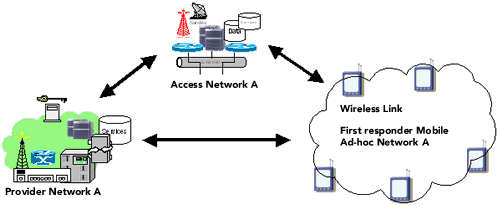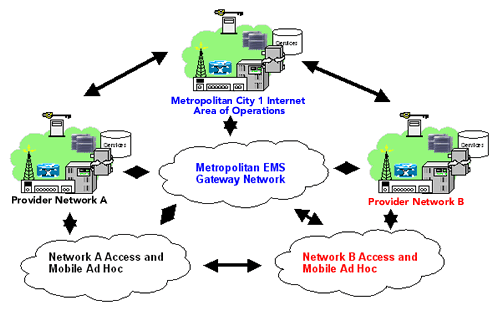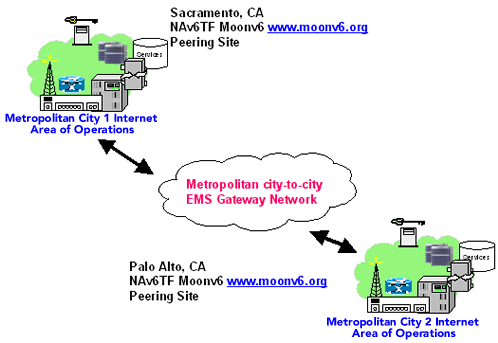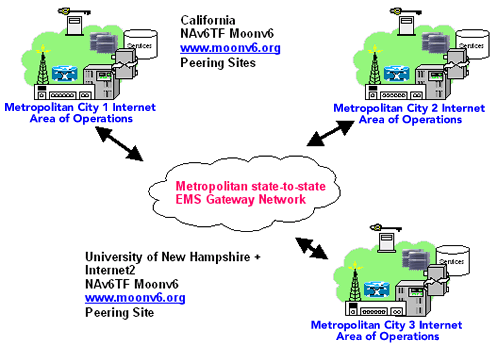Home ~ Example ~ Links ~ Contact Us

An example of MetroNet6 is as follows. In a U.S. city or town the State Police, Fireman, Hospital 911 Personnel, Local Police, and any other required Local Authorities would have Handheld Devices that would have their own Metropolitan Network (MetroNet6) for Voice, Video, Graphics, Intelligence, Medical, and other forms of data through multimedia communications 24x7x365. This MetroNet6 would emulate a command and control center, using Moonv6 www.moonv6.org, over the Internet to an emulated National Homeland Security Office securely for communications updates. The MetroNet6 would support both wireless and wireline technology as the physical medium for communications and the integration of wireless and wireline so either can be used on the MetroNet6. The MetroNet6 would support the ability for a command center to be established in an Ad Hoc manner to communicate with the MetroNet6 Homeland Security force and emulated National Homeland Security Office using wireless or wireline communications. In addition, the MetroNet6 over time should be able to add additional Ad Hoc Sub-Networks in as required such as the emulated National Guard, Air Command, or other U.S. Agencies that must connect to the MetroNet6 during a 911 disaster.
FOR MORE INFO CONTACT: geof lambert 916-852-6769 or George Usi 916-484-1111

Proposal ˆ MetroNet6 Home Land Security IPv6 R&D over Wireless
Prepared for California IPv6 Task Force www.cav6tf.org
From/By: Jim Bound CTO
IPv6 Forum
Chair NAv6TF
HP Fellow Jim.Bound@nav6tf.org
Overview:
A required technology capability within the U.S. for Home Land Security
is network communications between multiple forces 24x7x365 for prevention
of an attack, at the point of engagement during a 911 event, and the
ability for those forces to be commanded at any point in time in an
Ad Hoc manner. This requires the integration of multiple technologies,
911 communications platforms, and access to an Internet Infrastructure
within Home Land Security geography, and to the Office of Home Land
Security in Washington D..C. The technology capability should support
multiple simultaneous events engaged across the U.S. geography from
a single command control selected by the National Homeland Security
Office.
An example of the above is as follows. In a U.S. city or town the State Police, Fireman, Hospital 911 Personnel, Local Police, and any other required Local Authorities would have Handheld Devices that would have their own Metropolitan Network using IPv6 (MetroNet6) for Voice, Video, Graphics, Intelligence, Medical, and other forms of data through multimedia communications 24x7x365. This MetroNet6 would be connected over the Internet to an emulated National Home Land Security Office securely for communications updates.
The MetroNet6 would support both wireless and broadband technology as the physical medium for communications and the integration of wireless and broadband so either can be used on the MetroNet6. The MetroNet6 would support the ability for a command center to be established in an Ad Hoc manner to communicate with the MetroNet6 Homeland Security force and an emulated National Homeland Security Office using wireless or broadband communications. In addition, the MetroNet6 should be able to add additional Ad Hoc Sub-Networks as required such as the emulated National Guard, Air Command, or other U.S. Agencies that must connect to the MetroNet6 during a 911 disaster.
Most of the technology to develop this communications exists today, but the core technology requires further testing and integration as a complete solution. The backbone technology to support a MetroNet6 effort is the underlying Internet Protocol Layer that will permit the transmission and reception of communications, and in an Ad Hoc manner. The Internet Protocol version 6 (IPv6) is the Next Generation Internet Protocol to support communications over the Internet and private networks into the 21st century. IPv6 is able to provide the necessary infrastructure to support the MetroNet6 and National Homeland Security Office,
IPv6 is the core technology to build a MetroNet6 communications network, but requires other technologies to be integrated, below is an overview of the core technology integral components that require analysis:
- Mobile IPv6 routing which permits MetroNet6 nodes to connect and re-connect while moving across the MetroNet6 infrastructure, and any Ad Hoc Sub-Networks joining the MetroNet6.
- Large Scale network formation of new Ad Hoc Sub-Networks to join MetroNet6.
- Security using a Public Key Infrastructure at the IPv6 layer that supports an absolute trust model between two peers on the MetroNet6, Ad Hoc Sub-Networks, or to National Homeland Security Office.
- Integration of Homeland Security applications required for 911 operations and MetroNet6 forces.
- Network Management of MetroNet6 operations and security infrastructure.
The proposal is to build a prototype MetroNet6 in the State of California beginning in Sacramento, with communications city-to-city with Palo Alto. In addition, state-to-state MetroNet6 network communications would be part of the project. For city-to-city and state-to-state communications the current NAv6TF Moonv6 www.moonv6.org project can provide an IPv6 native backbone peering network to be used. Below is an initial analysis for the MetroNet6 proposal.
What problem is MetroNet6 addressing?
The basic problem to be addressed is first responder network communication connectivity and interoperability.
In addition different first responder organizations must be able to communicate, and be interoperable across
their respective networks. Also required is a metropolitan network infrastructure to support first responders,
and then expanding that network between cities and states supporting a complete Emergency Management Network (EMN)
network infrastructure. A high level view the problem addressed is as follows:
- End-2-End secure network communications for first responders and
across their metropolitan area of operations emergency support
infrastructure, using IEEE 802.11x, the Internet Protocol suite, IPv6,
and Mobile IPv6 to provide security, discovery, connectivity, and
interoperability.
- Communications within specific first responder networks.
- Communications between multiple first responder independent networks.
- Communications within area of operations metropolitan EMN Internet Network command control.
- Communications between metropolitan EMN Internet Network city-to-city-command control.
- Communications between metropolitan EMN Internet Network state-to-state-command control.
The customers for MetroNet6 are the organizations, persons, and infrastructure that support an event that requires an EMN operation.
- Federal Government Home Land Security supporting EMN Internet Network.
- State Government supporting EMN Internet Network.
- Metropolitan Government supporting EMN Internet Network.
- First Responders
- Police
- Fire Department
- EMN Rescue
- Hospitals and Doctors
- State National Guard
- Other crisis management support infrastructure
- Other law enforcement agencies
Communications within specific first responder networks.
Viewing MetroNet6 from bottom-up the first requirement is to define
and design a network architecture and topology that supports a single
specific first responder organization. The topology and networks for
a specific first responder are provided below.

Communications between multiple first responder independent
networks
Below depicts view supporting two independent first responder organizations
needed for an EMN event.

Note: Metropolitan EMN Internet Network does not exist in this use case example.
Communications within area of operations metropolitan EMN Internet
Network
command control.
Below the network view and implementation now provides connectivity
to all first responders within the metropolitan EMN network infrastructure.
This reduces the network communications requirements between independent
first responder networks with this enhancement, and a network topology
implementation point to note.

Communications between metropolitan EMN Internet Network
city-to-city-command control.
Below the network view now connects two metropolitan EMN operations
across a network infrastructure between two cities.

Communications between metropolitan EMN Internet Network
state-to-state-command control.
Below the network view now extends and connects metropolitan EMN operations
between two states.

MetroNet6 Proposal Initial Outline Criteria
An initial approach to develop a proposal for MetroNet6 prototype would
follow the base criteria below to develop a complete proposal for the
implementation of the use cases presented.
- Previous figures define high-level use cases and network topology design center.
- Internet Protocol Layer would use IPv6 as dominant for End-2-End node communications and routing protocol (all nodes capable of IPv4 and IPv6)
- Security will be critical and IPsec should be used as first order of defense, but other ambient security methods will be required within MetroNet6.
- Link Layer would use IEEE 802.11x protocols.
- Seamless Network Mobility would use Mobile IPv6 and enhancements as defined in IETF Network Mobility group (NEMO).
- But, first responders must be able to operate without NEMO infrastructure too.
- NAv6TF Moonv6 backbone would be used for inter-city and inter-state network communications.
- First responder specific networks would have to define and select a Mobile Ad Hoc Networking routing protocol, with support from CAv6TF and NAv6TF networking SMEs.
- Various Internet Networks would need to be defined and designed, with support from CAv6TF and NAv6TF networking SMEs.
- IPv6 Transition mechanisms will be required to interoperate with legacy operations and applications that have not moved to IPv6, with support from CAv6TF and NAv6TF networking SMEs.
- Wireless and broadband networking infrastructure would have to be defined and determined to support MetroNet6 various network topologies.
Mobile Ad Hoc Network Properties
- Network is usually wireless.
- Network is not permanent.
- Network must be self-forming and self-healing.
- Access to services from External Internet Network may be direct or through an Access or Gateway network.
- Access Network and Internet Network may also be mobile.
- Greatest connectivity and interoperability achieved with the Internet Protocol suite for networking layers, and to support seamless routing.
- Network must be able to hear broad wireless router advertisements beacons (e.g. Geocast, Anycast)
- Each node on the network may be a router.
- Each node on the network will usually be powered by batteries.
- The link environment the nodes operate can be affected by local interference and terrain.
- Each node on the network will often communicate over a radio network infrastructure.
- The radio network infrastructure must interoperate with the Internet Protocol Suite for maximum open systems connectivity and interoperability.
- Using IEEE 802.11x provides open link media standard and off-the-shelf commercial devices, and evolution towards Next Generation Networks.
Battery Life Exhaustion Ad Hoc Nodes
- Listening to network traffic for network topology updates.
- Transmission and reception of data.
- Network security operations.
- Informing correspondent nodes of location change.
- Performing as a router on the Ad Hoc Network Link.
- Basically all self-forming and self-healing operations
Routing and Mobile Ad Hoc Nodes (MANET)
- Current Distance Vector routing protocols will not scale for more than hundreds of nodes, all experimental.
- Current Link State Packet routing protocols require much state and memory and will not scale for more than thousands of nodes (e.g. sensor nets and convergence of multiple Ad Hoc Networks), all experimental.
- Custom or Proprietary MANET user space protocols will not interoperate, and in use today (note - this breaks network centric operations when not using the Internet Protocol Suite)
- Link Media for two Ad Networks could be different link types today.
- Currently this is all work in progress and in debate in standards bodies and industry.
- MANET could be new layer added to the Internet Protocol Suite for implementation.

MANET Basic Properties
- Nodes on links must be able to discover each other.
- Nodes on links must be secure within that link.
- Nodes on links must be able to discover routes to other networks.
- Nodes on links should be able to operate in stateless manner whenever possible, within the context of network communications operations.
- Nodes on the link will be required to maintain routing topology at a minimum, and be able to forward packets for other nodes on the link at a maximum.
- Ad Hoc Networks must be secure to Access, Gateway, and Provider network service networks.
- Ad Hoc Networks can be multi-homed to one or more external networks.
- Ad Hoc Networks must be able to join and form one Ad Hoc Network, from nodes perspective.
- Ad Hoc Networks that use Middle Boxes or Software Overlay Paradigms for QOS, Connectivity or as Application Relays can suffer performance, delay, and security penalties within their network communications operation.
Mobility Basic Properties
- Mobile IP provides a solution for Seamless Mobility to Nodes on an Ad Hoc Network.
- MANET layer should be transparent to Mobile IP implementation and interoperability on the Node.
- Node must be able to inform Correspondent Node and Home Agent that network location has changed.
- Node must be able to discover new Home Agents at any point in time.
- Mobile Home Agents must be replicated to provide true network context data store high availability at the Access or Provider networks.
- Mobile Home Agents must be able to be discovered by Mobile Ad Hoc Nodes at the Access or Provider networks.
- Provider and Access Networks may be Mobile themselves.
IPv6 Operational Benefits Mobile Ad Hoc Networks
- IPv6 Stateless Autoconfiguration and Node discovery on links and networks.
- Mobile IPv6 inherent properties supported by all IPv6 nodes as requirement.
- IPv6 extended options format behind the IPv6 header.
- IPsec is mandatory requirement for nodes supporting the IPv6 protocol.
- IPv6 Header flow label and destination options header prior to encrypted payload with IPsec to support QOS and additional Security mechanisms.
- IPv6 node implementations have the ability to change from host node to router node in stateless manner.
- IPv6 restoration of E2E model and larger address space.
- IPv6 hierarchical and aggregate prefixes for network topology definition.
- Mobile IPv6 routing optimizations.
- Mobile IPv6 security optimizations.
- IPv6 transition mechanisms can assist with transformation from current network deployments to network centric Next Generation Networks operation.
Mobility and Ad Hoc Networking State
- Network Technology is evolving and on fast track (e.g. IPv6, Mobile IPv6, MANET, Wireless Link Layers, E2E Security Model) with some initial products in the market performing initial testing.
- Current implementations are proprietary and often require middle boxes and NAT work-around, proprietary software network mesh overlays, and not usually E2E network capable for many applications or security.
- Industry consortia's and standards bodies aggressively working on the standards and deployment problem (e.g. IETF, IEEE, 3GPP, NAv6TF, NCOIC, The Open Group).
- Planning requires network centric operations view, using the Internet Protocol Suite as Connectivity and Interoperability Compass, and defining a transition and transformation from current network models.
Summary
MetroNet6 is a proposal and idea to assist the development of first responder network communications solutions
to evolve to Next Generation Networks, the IPv6 operational advantages, verify that an E2E security trust
model can be deployed, the use of off-the-shelf commercial technology where possible, and support a network
centric view of connectivity and interoperability across a set of metropolitan EMN networks, based on open
standards and solutions.
MetroNet6 will benefit other efforts within industry and society as verification that the technology for MetroNet6 is in fact implemental and available to the market. The NAv6TF and CAv6TF would be able to provide networking SMEs to assist with the project to get started, and provide volunteer non-vendor view advisory council role for the implementation of a MetroNet6 project, in the interest of the greater good and the deployment of Next Generation Networks using IPv6 and supporting E2E network centric operations.
Sincerely and Respectfully,
/jim
"The art of poetry is the ability to put the ocean in a glass"
Home ~ Example ~ Links ~ Contact Us